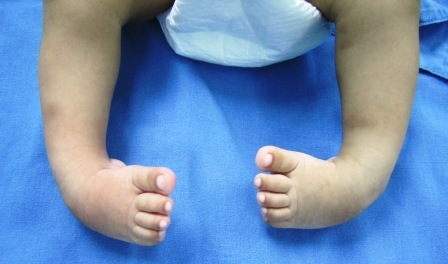At Dr Sarwar Physiotherapy Centre in Dwarka, we approach problems from the area of paediatric physiotherapy in Dwarka that affect the smallest among which are rare neurological diseases or rare diseases, such as multiple congenital arthrogryposis.

What is congenital multiple arthrogryposis?
Congenital Multiple Arthrogryposis or AMC is a non-progressive congenital neuromuscular syndrome, that is, it occurs during pregnancy and becomes evident at birth.
It is a rare disease, it is estimated that in India it occurs in 1 of every 10000 births and affects children equally.
It is estimated that there are many types of AMC, about 400 types, the most frequent being neuropathic arthrogryposis, myopathic arthrogryposis and amyloplastic.
Why is it produced and what signs/symptoms appear?
It is usually due to a restriction of the movement of the foetus during pregnancy, which can occur for several reasons, such as inadequate development of the foetus’ musculoskeletal system during pregnancy, insufficient amount of amniotic fluid or little intrauterine space, alteration of the central nervous system or peripheral of the foetus, etc.
In short, any things that limits the movement of the foetus during pregnancy can produce muscle contracture and its subsequent joint limitation with greater or lesser severity, affecting upper and/or lower limbs (especially in shoulders, elbows, wrists, hands, hips, knees and feet), spine, jaw, etc.
These symptoms can be compared to the placement of a cast on an arm for a fracture, which after a short period of time can generate immobilized joint stiffness and muscle atrophy. In this case, the symptoms are temporary, resolving spontaneously and with the help of physiotherapist in Dwarka. However, if this limitation of movement occurs during pregnancy, it causes greater severity and therefore requires a specific and individualized approach.
Which is the treatment?
– Orthopaedic treatment: use of splints or orthopaedic devices that are progressive and adaptable to the child’s growth. They can be used during the day or at night, being important to prevent the increase of the deformity of the affected joint.
– Physiotherapy: will be a basic pillar in the treatment of this problem, both to improve joint range, as to increase the strength of the muscles and prevent the onset or worsening of the stiffness of affected joints. This will allow the child to improve his movement during the activities of daily life, for which reason an adapted and individualized treatment should be elaborated to the needs of the child and his family.
– Surgical treatment: sometimes it is necessary to perform surgery by orthopaedic surgeon in Delhi to correct the position of the affected joints, if conservative treatment is not enough.
At Physiotherapy clinic in Dwarka, we have the best physiotherapist in Dwarka who will approach the child from a multidisciplinary approach, being able to perform hydrotherapy or aquatic therapy, respiratory physiotherapy and child or paediatric physiotherapy.
*
Be the first to comment.